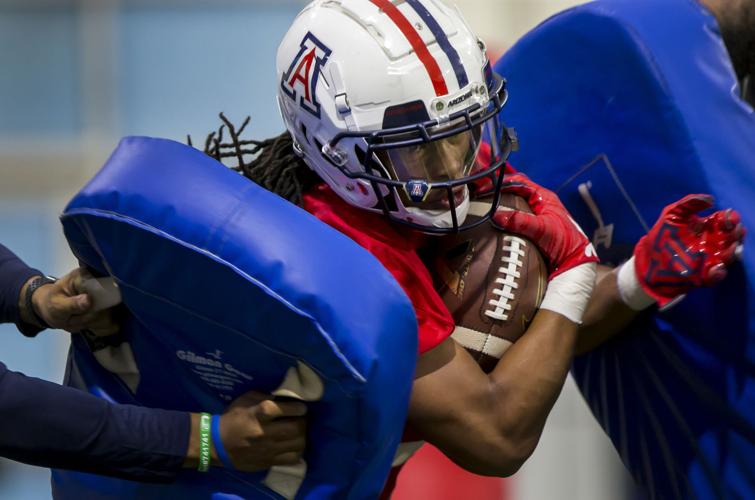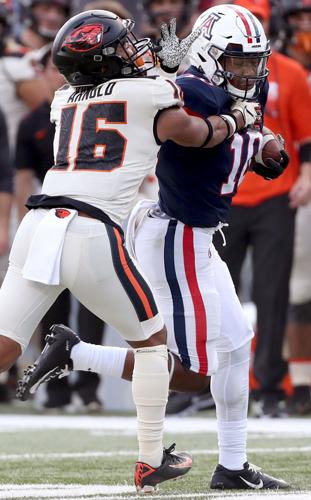Editor’s note: This is the first in a three-part series examining what might have been – and could still be – for Arizona Wildcats football after the Pac-12 postponed the fall season. Today: the offense.
The Arizona Wildcats had problems, but they had a plan. Kevin Sumlin and his staff spent the offseason, such as it was, trying to plug holes. They couldn’t fill them all. But there was cause for optimism.
We’ll never know how the 2020 Wildcats would have fared … in 2020. On Aug. 11, the Pac-12 announced it was postponing all sporting competitions through the end of the year because of the pandemic. There will be no college football in Tucson, Tempe or any league locale this fall.
A winter/spring alternative is being discussed, provided all the needed safety and testing measures can be implemented. The interim offers an opportunity to examine what might have been this fall — and what could still be in early 2021.
To that end, we’ll break down the UA roster, position by position, over the next three days. First up, the offense:
Quarterbacks
This fall was supposed to be the coming-out party for sophomore Grant Gunnell. The festivities are on hold for the time being.
Gunnell entered Arizona’s abbreviated spring practice as the presumptive No. 1 quarterback after excelling in a part-time role as a freshman. The record-setting passer from Texas compiled a 9-1 touchdown-to-interception ratio with a 65.2% completion rate. The analytics-based Pro Football Focus this week ranked Gunnell as the 13th-best projected starter in the nation and called him “a breakout waiting to happen.”
Redshirt sophomore Kevin Doyle had a chance to at least earn the No. 2 spot, but the shortened spring robbed him of valuable practice reps. Doyle then decided, before the Pac-12’s announcement, to opt out of the 2020 season because of health and safety concerns. In light of the NCAA’s reported eligibility ruling, he’ll have three more years to play, whether here or elsewhere.
Assuming Doyle doesn’t have a change of heart, the top backups in a winter/spring season would be veteran Rhett Rodriguez and freshman Will Plummer — with another freshman possibly in the mix. Class of 2021 commit Clay Millen plans to enroll in January. Whether midyear enrollees will be eligible to play in a winter/spring season remains to be seen. At the very least, Millen and the other January arrivals will benefit from being around the team.

Gary Brightwell, who has shown flashes of greatness while sharing time at running back, rushed for 915 yards and eight touchdowns with a 5.8-yards-per-carry average in 2018 and ’19.
Running backs
Arizona’s deepest position? Perhaps — even after the departure of multiyear starter J.J. Taylor.
The favorite to start was and is senior Gary Brightwell, who has shown flashes of greatness while sharing time with Taylor and others. Brightwell rushed for 915 yards and eight touchdowns with a 5.8-yards-per-carry average in 2018 and ’19.
As for winter/spring participation, Brightwell falls into a category of players who’d have a difficult decision to make. Brightwell has NFL measurables. He also never has been a full-time starter. Still, would it be worth it for him to play in early 2021 with the draft coming soon after?
Arizona has three other veteran backs on scholarship, plus two recently arrived freshmen.
Nathan Tilford is a senior academically, a redshirt junior in terms of eligibility. It took him some time to earn the coaches’ trust, but whenever he has gotten a chance, he has thrived (6.9-yards-per-carry career average).
Redshirt sophomore Bam Smith and sophomore Michael Wiley have displayed dual-threat skills in part-time duty. Freshman Frank Brown arrives with the same reputation – but with more speed. Brown likely would have had a role this fall, whether as a running back, slot receiver, return specialist or all of the above.
Fellow freshman Jalen John might have had a hard time cracking the lineup given how many viable options are on the roster. Then again, a full training camp also would have given him a chance to impress first-year position coach AJ Steward.

Arizona wide receiver Jamarye Joiner, a former quarterback, flashed considerable upside — 34 catches for 552 yards and five touchdowns — in his first season as a pass catcher.
Receivers/tight ends
Wide receiver rivals running back in terms of depth and talent, but the position suffered a blow this week.
Brenden Schooler, a graduate transfer from Oregon, decided to reenter the NCAA transfer portal with the goal of landing at a school that will play this fall. His younger brother Colin Schooler, a three-year starter at linebacker, joined him. Brenden Schooler likely would have been the Wildcats’ top outside receiver.
With Brenden Schooler out of the mix, Arizona will seek even more from rising sophomores Boobie Curry and Jalen Johnson when games resume. Curry, Gunnell’s high school teammate, caught six passes for 68 yards as a freshman. Johnson caught seven balls for 79 yards and a touchdown. Like Schooler, both are listed at 6 feet, 2 inches.
Arizona’s three leading returning receivers primarily played in the slot last season. Redshirt sophomore Jamarye Joiner is bigger than a typical slot at 6 feet, 1 inch and 210 pounds, and the former quarterback flashed considerable upside — 34 catches for 552 yards and five touchdowns — in his first season as a pass catcher. Redshirt junior Brian Casteel led the Wildcats with 45 receptions and has more big-play capability than his per-catch average of 8.8 yards would suggest. The same goes for speedy senior Tayvian Cunningham (35-383-2).
Three-year starting tight end Bryce Wolma entered 2020 seeking a bigger role in the passing attack after catching only five passes each of the past two seasons; he snagged 28 as a freshman in 2017.
Junior college transfer Stacey Marshall joined the tight end group in January, and the early reviews from spring practice were positive. He should be ready to contribute immediately.

Lineman Donovan Laie has started every game — 24 straight — since he first put on a UA uniform two years ago.
Offensive linemen
Arizona has the makings of a solid offensive line on paper (a term that applies to the entire Pac-12 at this point, really).
The anchors since Sumlin and his staff got here in 2018 have been center Josh McCauley and tackle/guard Donovan Laie.
McCauley, who has started 22 of Arizona’s past 24 games, is a fifth-year senior who will have to decide how much longer he wants to play. In theory, per the NCAA’s eligibility update, McCauley would be able to play in winter/spring and fall in 2021 if he so desired.
Laie has started every game — 24 straight — since he first put on a UA uniform two years ago. He mostly has played tackle but shifted to left guard late last year when the coaching staff elevated then-freshman Jordan Morgan to the starting lineup at left tackle. Morgan and Laie likely would form the left side, with Laie available to play either tackle spot if need be. Both players have pro potential.
(Something to be aware of: Laie has endured great pain in his personal life over the past year, including the death of his father. Laie played in last year’s finale vs. Arizona State even after learning about a week earlier that his dad had passed away.)
The right side likely would consist of some combination of Robert Congel, Josh Donovan and Paiton Fears.
All three are transfers who contributed to varying degrees last season. Congel can play all three interior spots. Donovan can play guard or tackle. Fears split time at right tackle with Edgar Burrola, who remains suspended after he violated the UA’s coronavirus protocols.
Sumlin and his staff have endeavored to restock the line in the past two recruiting classes. JC transfer Sam Langi is the newcomer most likely to play right away whenever games resume.








